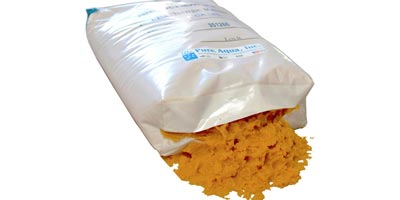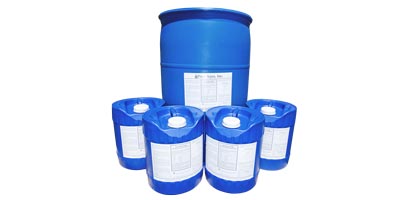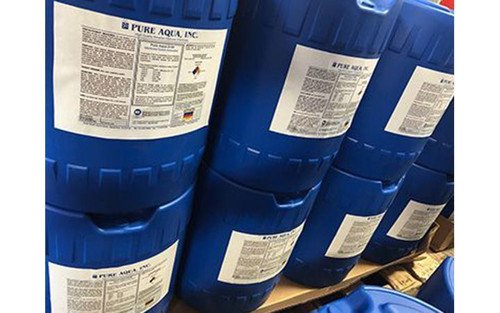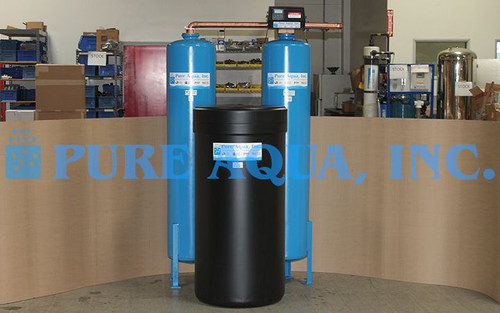- Soft water or a water softener
- Antiscalant system
In addition, another key concern is the constituents to be controlled. If hardness-related scale is not the only issue (e.g. silica, low-level of dissolved metals), then of course antiscalant/antifoulant can offer broader or more targeted control. In addition, softeners require maintenance and upkeep to ensure they don’t harbor biological growth.
 |
 |
|
Water Softeners: An ion exchange water softener can reduce or eliminate hardness problems and act as a good pretreatment for tap water RO system.
|
Antiscalant and antifoulant dosing system: RO/NF membrane systems that use antiscalant avoid mineral scaling and thus can operate for extended periods of time between membrane cleanings. Also, antiscalants allow RO membrane systems to remove far more pure water from each gallon of feed water than would otherwise be possible. It also has a control of scale at up to 100x saturation values or higher. |
[custom-specifications]
With the increase in use of membrane filtration processes, issues of scale formation resulting in membrane fouling have also been on the rise; severely impacting the performance of the filtration systems; especially in Nanofiltration NF and Reverse Osmosis RO membranes.
With reverse osmosis and nanofiltration systems, it is always best to prevent the scaling of your membranes. When RO/NF membranes scale up, the flow rate drops and the pump can overload. There are two ways to prevent scaling of your reverse osmosis system.
While both methods are effective as pretreatment before a membrane system, the decision comes down to the size of the system. For smaller systems with a feed rate of less than 20 gpm, it can be difficult to inject as little as 3-5 ppm of antiscalant into the feed stream. If injecting antiscalant into a 20 gpm feed at a rate of 4 ppm, the amount of a standard antiscalant solution required per 24 hours of run is about 0.11 gallons. By diluting the antiscalant 9:1, the injection rate becomes 1.1 gallons per 24 hours. During the same period, depending on the hardness level in the feed, an ion exchange softener may require about 75 lbs of salt to regenerate (5 grains/gallon, or 85 ppm of total hardness). It might be possible to consider a system this size (20 gpm feed rate, 10 gpg hardness), as the tipping point between an ion exchange softener and antiscalant injection. As systems become larger, one uses both more salt and more antiscalant. However, the equipment cost remains roughly the same for antiscalant injection and increases with larger softeners. In the above instance, an operator uses either 75 lbs. of salt or .11 gallons of antiscalant to control scale. Generally, antiscalant chemicals are less costly than salt. Generally speaking, sanitary sewer and septic systems don’t appreciate the sodium chloride that softeners contribute, as it may negatively impact the biological treatments that are often employed. A solution to this problem would be to substitute potassium, although it is more expensive than sodium chloride.
[/custom-specifications]
[custom-features]
Ion Exchange involves removal of hardness causing ions such as Calcium and Magnesium and replacing them with ions which don’t cause hardness. This process is reversible and uses a synthetic resin as the medium to carry out the exchange. After the resin has become saturated with the unwanted ions (Resin has a greater affinity for these unwanted ions such as calcium, magnesium and other cations), it is regenerated by washing it with a solution of the desired ion, which is NaCl in this case.
Antiscalants can be used to control carbonate scaling, sulfate scaling, and calcium fluoride scaling. There are generally three different types of scale inhibitors: sodium hexametaphosphate (SHMP), organophosphonates and polyacrylates. These chemicals function by one or more closely related mechanisms, which interfere with or disrupt the crystal growth stages.
[/custom-features]
[custom-usage]
Water softeners advantages:
- Reduces water hardness to below 1 grain per gallon (GPG)
- Chemicals are not required
- It can remove traces of iron from water
- Better choice for smaller systems
Antiscalant and antifoulant dosing system advantages:
- No salt required
- It is effective against silica SiO2, iron, manganese, carbonates, sulfates and others
- Requires less footprint
- Extends RO or NF membranes life
- Works with up to 150 grains of hardness
- Less operating costs than water softeners
[/custom-usage]
-
Quality and ease of use...
Superb price, quality and ease of use on these complete system.
- Related Project1:
- https://pureaqua.com/pilot-reverse-osmosis-system-for-antiscalant-testing-3000-gpd-usa/
- Related Project2:
- https://pureaqua.com/commercial-reverse-osmosis-plant-3-x-32000-gpd-venezuela/
- Related Project3:
- https://pureaqua.com/automatic-triple-water-softener-for-drinking-400-gpm-usa/
- Related Project4:
- https://pureaqua.com/commercial-twin-alternating-water-softening-system-for-drinking-water-100-gpm-usa/
 ENGLISH
ENGLISH ESPAÑOL
ESPAÑOL العربية
العربية PORTUGUÉS
PORTUGUÉS FRANÇAIS
FRANÇAIS













